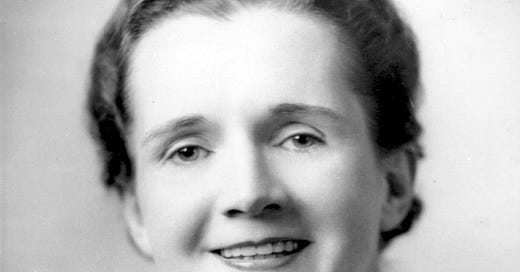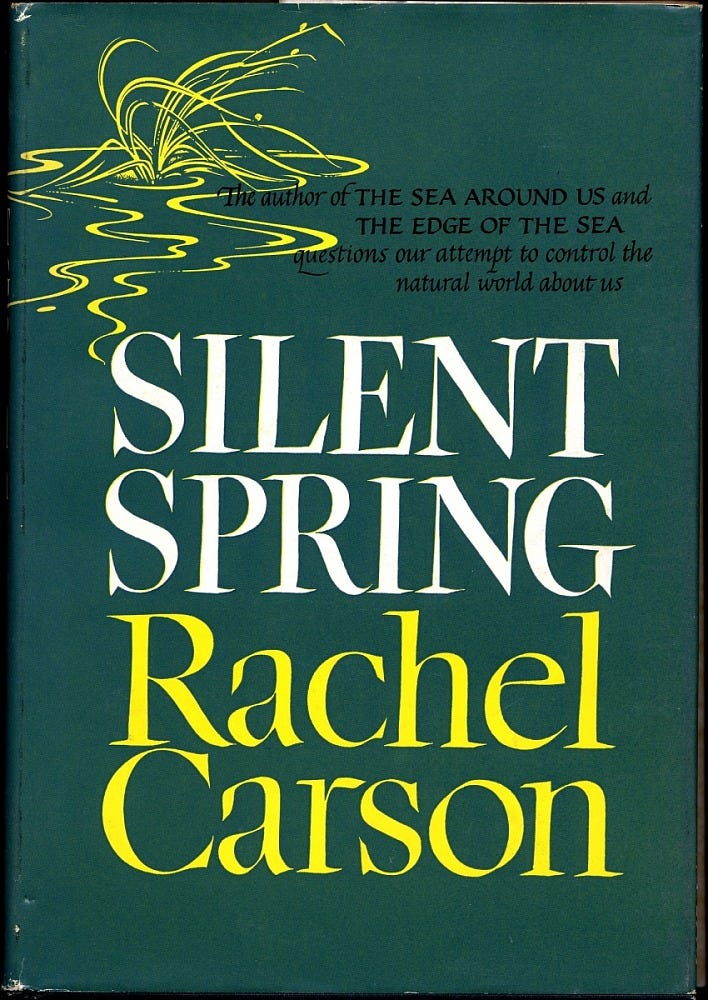Never underestimate the power of a woman
Rachel Carson's Silent Spring, a book that changed the world
Never underestimate the power of a woman
“I believe that the more clearly we can focus our attention on the wonders and realities of the universe about us, the less taste we shall have for destruction” _Rachel Carson, 1954

Already, since the 1940s, it has become difficult to ignore the impact of human activities on the environment. As early as 1943 a thick smog trapped the residents of Los Angeles in an unhealthy shroud of air pollution that came to be known as Black Monday. In 1948, a deadly smog hung over the Monongahela Valley, left twenty people dead and six thousand ill, mainly in the town of Donora, southeast of Pittsburgh. Perhaps the worst case of air pollution was that of London in 1952 when a deadly fog killed more than four thousand people.
Several major shifts occurred in the 1950s and 1960s which involved an awareness of the ties between environmental and social problems. The hydrogen bomb and nuclear testing peaked and had triggered a “ban-the-atomic-bomb” movement, which intensified after the Lucky Dragon incident in 1954. As the story goes, in the early hours of 1st March, the 23-man crew of a small Japanese fishing vessel witnesses the sun rising in the west, not the east, followed by a tremendous thunder. The crew was accidentally showered with radioactive ash caused by a United States hydrogen bomb test on the Bikini Atoll in the South Pacific. By the time the vessel returned to its homeport, almost two weeks later, many of the crew members were suffering from all known symptoms of radiation poisoning.
The Lucky Dragon incident has become a catalyst for a worldwide movement that changed the course of the arms race in the midst of the Cold War and fuelled the determination of a growing number of scientists who were speaking out against weapons of mass destruction, setting the ground for one of the greatest international agreements of the twentieth century, the Partial Nuclear Ban Treaty of 1963, which was signed by the United States, Soviet Union, and Great Britain, and prohibited the testing of nuclear weapons in outer space, the atmosphere and underwater.
At the same time, scientists began noticing something curious: nuclear explosions caused the gradual depletion of the ozone layer, which protects the Earth’s atmosphere. In his 1957 book Atomic Suicide, Walter Russell explains that with radioactive elements unleashed into our atmosphere, the human race is heading for catastrophe.
“The element of surprise which could delay the discovery of the great danger, and thus allow more plutonium piles to come into existence, is the fact that scientists are looking near the ground for fallout dangers. The greatest radioactive dangers are accumulating from eight to twelve miles up in the stratosphere. The upper atmosphere is already charged with death-dealing radioactivity, for which it has not yet sent us the bill. It is slowly coming and we will have to pay for it in another century, even if atomic energy plants ceased today.”
……..
But it was another book that really widened the public awareness of environmental issues. In 1962, Rachel Carson, a soft-spoken marine biologist and naturalist, published her seminal work Silent Spring, a ground-breaking book that will revolutionise our relationship with the natural world.
Rachel Carson was already a respected and talented nature writer. She knew how to explain science to ordinary readers and she understood that only if she could make her readers fall in love with nature, the seas, the forests, and the birds, only then, they will act to save them.
The subject of Carson’s book was human poisoning of the biosphere through the widespread deployment of synthetic chemicals aimed at pest and disease control, especially DDT (dichlorodiphenyltrichloroethane) which was being used widely to control mosquitoes and other insects.
DDT is the most powerful pesticide the world has ever known. Unlike most pesticides, whose effectiveness is limited to destroying one or two types of insects, DDT was capable of killing hundreds of different kinds at once. It was developed in 1939, by the chemist Paul Hermann Müller, who was looking for an insecticide to protect woollens against moths. For his discovery, he received the 1948 Nobel Prize in Medicine.
DDT was used extensively during World War II, clearing the South Pacific islands of malaria-causing insects for U.S. troops, and became available for civilian use in 1945. In only a few years its use proliferated. It became the solution to every insect problem and not only that. It was used extensively in agriculture, to stop the spread of typhus, and as delousing powder. But there was a problem, as Carson’s meticulous work showed. DDT entered the food chain contaminating the world's food supply.
It accumulated in the fatty tissues of animals, including human beings, causing cancer and genetic damage. “Interconnected food webs could take DDT from cornfields in Iowa to the bladder of Antarctic seals just as the stratosphere could deliver fallout thrown up at Bikini Atoll into the tooth enamel of German infants,” writes Oliver Morton in his book The Planet Remade.
Silent Spring became an international best-seller, selling more than 500,000 copies in 24 countries. Its impact was enormous. Carson changed the prevailing public mindset that humans are separate from nature, showing that the health of our environment directly affected us.
Her book was met with furious resistance, chiefly from the big chemical companies. They have tried to destroy Carson's scientific credibility. They presented her as a fanatic, a dangerous reactionary “who would drag modern society backwards into a new Middle Ages filled with pests, vermin, crop destruction, and lethal diseases”. The attacks towards her were sexist and personal. Ezra Taft Benson, former US Secretary of Agriculture, wrote in a private letter that because Carson was unmarried despite being attractive, she was "probably a communist".
Rachel Carson influenced the environmental movement as no one had before. The Environmental Defense Fund (EDF), one of the world’s leading environmental NGOs, was initially formed in 1967 in reaction to the DDT problem. In May 1963, Rachel Carson appeared before the Department of Commerce and recommended that there be a “Pesticide Commission” to regulate the use of DDT, made up of independent scientific experts, in order there be no conflict of interest. Ten years later, Carson’s “Pesticide Commission” became the Environmental Protection Agency, which immediately banned DDT. Following America’s lead, support for the use of DDT quickly dried up, all over the world.
Rachel Carson died from breast cancer in early 1965. Shortly before her death, she appeared in a CBS documentary. She remarked:
"Man's attitude toward nature is today critically important simply because we have now acquired a fateful power to alter and destroy nature. But man is a part of nature, and his war against nature is inevitably a war against himself. [We are] challenged as mankind has never been challenged before to prove our maturity and our mastery, not of nature, but of ourselves."

Even today, the industry front group known as the Competitive Enterprise Institute (CEI) continues to defame Carson by insisting that “Carson’s anti-DDT rhetoric contributed to malaria outbreaks by encouraging many governments around the world to stop using it completely.” And, … “millions of people around the world suffer the painful and often deadly effects of malaria because one person sounded a false alarm. That person is Rachel Carson.”
Carson never called for a complete ban on DDT, just an end to its indiscriminate use. It was ultimately phased out not only because of the environmental damage it caused but also because it has steadily lost its effectiveness as mosquitoes have grown resistant to it. Rachel Carson had warned that this would happen too.
References and further reading
Rachel Carson, Silent Spring, Fawcett Publications, Inc.; New Impression edition (January 1, 1970)
Rachel Carson, “The real World Around us” speech to Theta Sigma Pi, Columbus, Ohio, 1954. In Lost Woods: The Discovered Writing of Rachel Carson. Edited by Linda Lear (Boston: Beacon Press, 1983)
Oliver Morton, “The Planet Remade” Granta (2015) pp 58
Michael B. Smith, “'Silence, Miss Carson! ... and the Reception of Silent Spring,” Feminist Studies 27, 3 (Fall 2001): 736–737.
RACHEL CARSON'S SILENT SPRING, A book that changed the world
Karen F. Stein, Rachel Carson: Challenging Authors, Sense Publishers, 2012
Rachel Carson’s Dangerous Legacy. Competitive Enterprice Institute, SAFEChemicalPolicy.org, March 1, 2007.Also, www.rachelwaswrong.org
Clyde Haberman, “Rachel Carson, DDT and the Fight Against Malaria,” New York Times, January 22, 2017.




